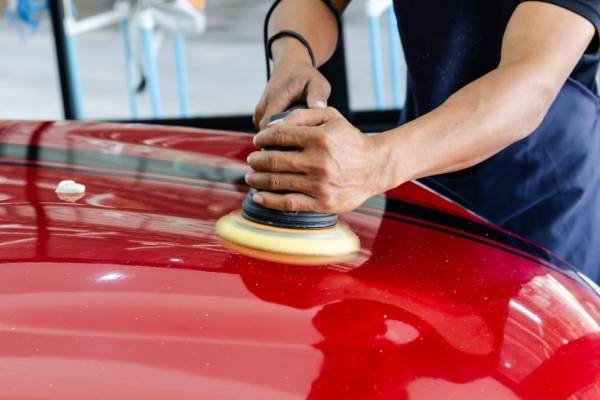Overview
There are few things that can depress auto fans more than finding ugly flaws in the flawless paint work of their car. Among these flaws, “fish eyes” are a prevalent and annoying problem. Fish eyes are little flaws that resemble craters in the paint job and detract from the car’s overall appearance. However, it is feasible to restore car paint damaged by fish eyes if you have the correct methods and a little perseverance. This post will examine the causes of fish eyes and the best methods for restoring the original gloss to the paint on your car.
Comprehending Fish Eyes:
The circular or crater-like flaws known as “fish eyes” are caused by improper paint adhesion to the surface. The moniker came from because these imperfections frequently resemble fish eyes. Contaminants that obstruct the paint bonding process are the primary cause of fish eyes. Silicone, oil, wax, and other foreign materials that come into contact with the surface while painting are examples of common contaminants. Fish eyes can also arise from inadequate surface preparation, inadequate cleaning, or mismatched paint and primer mixtures.
Appropriate Surface Readiness:
Complete surface preparation is essential for repairing fish-eye-damaged automotive paint. Carefully cleaning the affected area is essential before beginning any restoration work. To start, use a light detergent to wash the entire car to get rid of any loose particles, dirt, or grime. Pay close attention to the region that has fish eyes and make sure that it is absolutely clear of any impurities.
After cleaning the surface, remove any leftover residue with a wax and grease remover. During the repair phase, this step is essential to avoiding fish eyes from recurring. Apply a high-quality wax and grease remover uniformly, working in tiny parts at a time, using a clean, lint-free cloth.
Sanding the Area in Question:
Sanding the damaged area is the next stage in restoring automobile paint fish eyes after surface preparation. Use fine-grit sandpaper (600 or 800 grit) to sand the fish-eye area carefully. In order to improve paint adherence, the defects should be smoothed out and a surface created.
Take care not to sand too heavily since this could harm the nearby paint and make the issue worse. Throughout the procedure, apply uniform, controlled pressure with a sanding block. To get rid of any sanding residue, clean the area once more after sanding with the wax and grease remover.
Using Filler and Primer:
It’s time to apply a good primer to improve adhesion and produce a smooth basis for the paint once the surface has been smoothed. Select a premium vehicle primer that works well with the kind of paint you intend to use. As directed by the manufacturer, evenly apply the primer to the afflicted area and let it dry.
Before applying the primer, think about using a filler to level the surface if the fish eyes have caused deeper craters or defects. Automotive fillers, commonly referred to as glazing putty, can be primed, sanded, and applied to the damaged area to provide a smooth finish.
Choosing the Correct Paint:
An important part of the restoration procedure is picking the appropriate paint. Make sure the paint you choose works well with the primer and any additional materials you may have used. To reduce compatibility problems, it is best to use the same brand and product range for paint and primer.
Apply the paint in even, thin layers, letting each one dry fully before moving on to the next. This method encourages a polished, flawless finish and helps stop fish eyes from reappearing.
Final Details:
Examine the area for any flaws or unevenness after the last coat of paint has dried. To get a smooth finish, softly damp sand the painted surface using fine-grit sandpaper if needed. To preserve the newly restored paint and improve luster, use a high-quality car polish and wax afterwards.
In Con
Fish eyes-affected automotive paint restoration calls for perseverance, meticulous attention to detail, and a methodical technique. Fans may restore the original look of their car and maintain the integrity of the paint work by treating the underlying causes of fish eyes and using the right methods. For best results, always prioritize rigorous surface preparation, select high-quality materials, and pay close attention to each stage. Fish eyes can be frustrating, but with the appropriate methods, they can be a rewarding restoration success.


[…] Frequent Cleaning: To guarantee effective heat exchange, keep the condenser coils clean. To stop bacteria and mold from growing, clean up spills right away and wipe out the interior on a regular basis. […]
[…] There are occasions when having flexibility with pickup and delivery locations might save money. If the vehicle shipping firm of your choice provides terminal-to-terminal services, think about taking advantage of them to cut costs. If door-to-door service is more practical for you, make sure there is enough room for a truck to load and unload your car. […]
[…] In addition to being a convenient addition, a backup camera is essential for averting collisions, particularly in congested parking lots and small areas. To improve visibility and remove blind spots when reversing, look for a working backup camera when purchasing a secondhand automobile. […]
[…] You may also interest to read: Auto paint restoration techniques for ‘fish eyes’ […]
[…] a vehicle’s original aesthetic appeal primarily requires auto paint restoration. In addition to detracting from the car’s general appearance, faded, chipped, or damaged […]